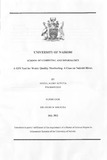| dc.description.abstract | Although many studies have been conducted to assess different aspects of pollution along the Nairobi
Rivers, there is a need to collate this information in order to identify areas of concern and gauge the extent
to which the rivers have been degraded. A Geographical Information System (GIS) tool was developed and
used to construct thematic maps for water quality of the Nairobi Rivers. Environmental data were
integrated and an overall picture about the spatial variation in the water quality of the rivers was defined.
The water quality maps were derived from the results of previous studies for physico-chemical parameters
like Total dissolved solids (TDS), Hydrogen Ions Concentrations (PH), Total Hardness (TH) and Nitrate
(NO3) concentration. The GIS maps showed not only contaminant distribution but also illustrated the need
to improve the water quality management methods.
Using the developed GIS water quality monitoring tool, water quality specialists can concentrate on
analyzing data and presenting their results without bothering about the details of the software application
being used. The GIS tool was developed using Quantum GIS (QGIS). This is a free open source desktop
GIS. The data being anlysed was stored in MS Access database, which was linked to the QGIS. A map of
Nairobi River basin was sourced from the ministry of Environment and natural resources. This map was
scanned, Georeferenced and digitized. The coordinates of the monitoring points along the river basin and
the corresponding water quality data were stored in the database. The database was queried to generate data
meeting specified criteria, e.g. TDS of the monitoring points in a specified period. The generated data was
then interpolated using the Inverse Distance Weighting (IDW) interpolation method, to generate water
quality maps for each of the parameters; TDS,PH,TH, and NO3. A combined quality map was then
generated by integrating the four thematic maps.
From this study, it was concluded that a multi-purpose GIS software tool can be developed and used to
automate many functions of water quality analysis. Further work can be done to improve the tool by
incorporating a menu to select all the quality analysis commands. Also a geospatial database, like
POSTGIS, could be used instead of MS Access. In addition, a Global Positioning System (GPS) device
could be used to accurately identify the coordinates of the monitoring points along the river basin. | en |

